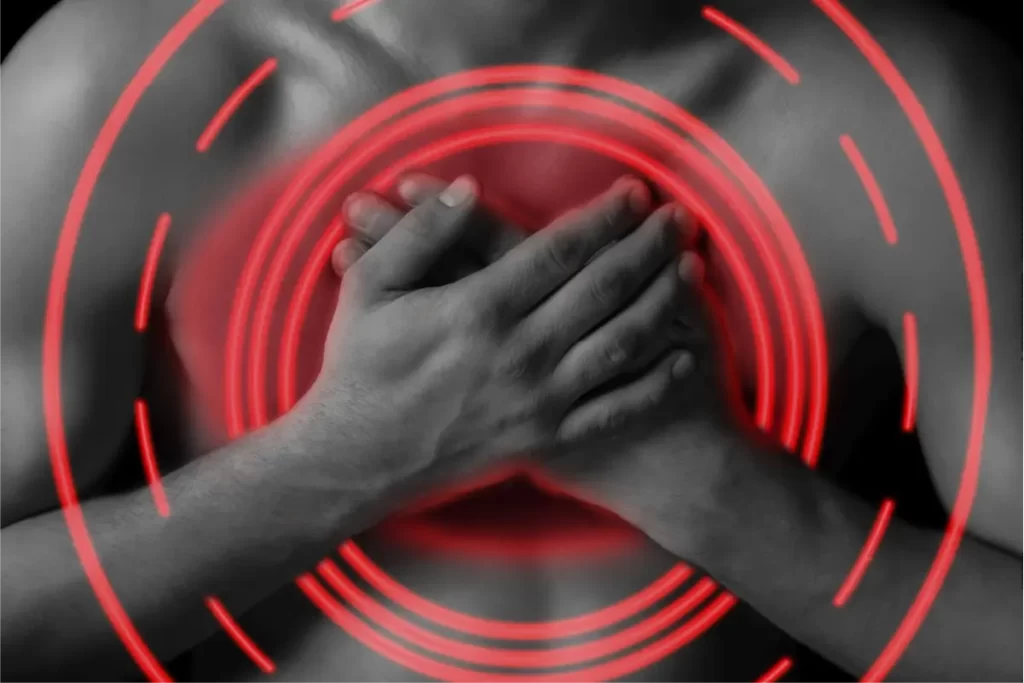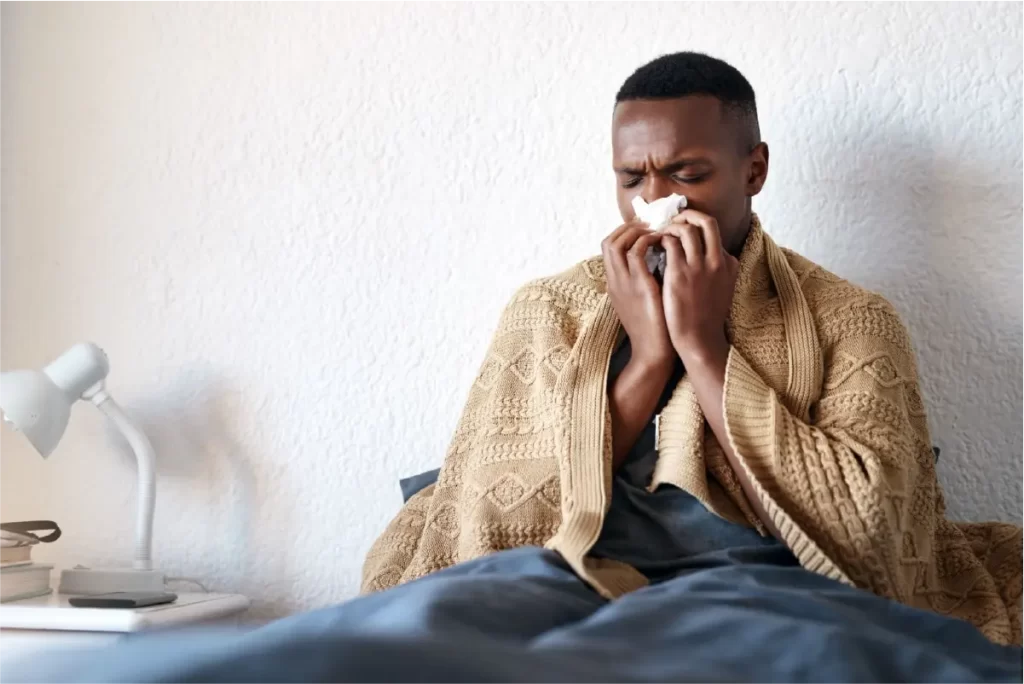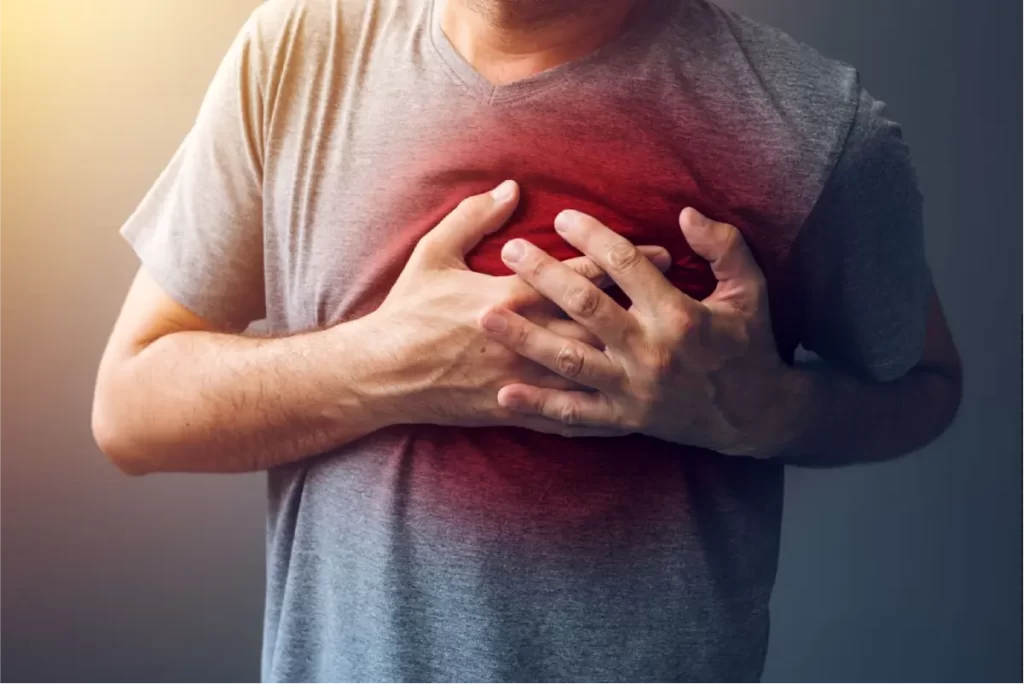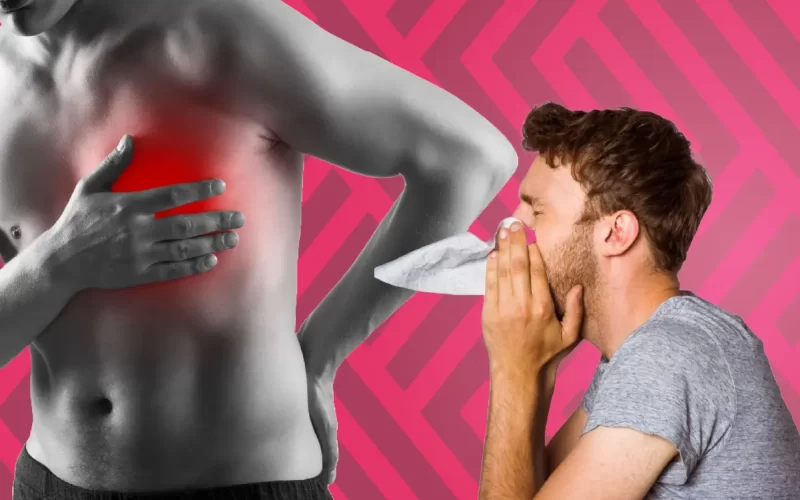Table of Contents Show
Sneezing is a natural reflex that helps clear your nose and throat of irritants. But sometimes, sneezing can cause a sharp pain in your chest that makes you feel like you’re having a heart attack. What causes this sharp pain in chest after sneezing and how can you prevent it?
Symptoms and Diagnosis of Chest Pain After Sneezing


Chest pain after sneezing is a common phenomenon that can have various causes and characteristics. The pain can vary in intensity, duration, location, and quality depending on the underlying condition that triggers it. Some of the possible causes of chest pain after sneezing are:
Some of the most common causes are:
- Pleurisy: This is an inflammation of the pleura, the thin layer of tissue that lines the lungs and chest wall. When the pleura is inflamed, it rubs against each other every time you breathe, causing a sharp pain that worsens when you sneeze, cough, or take a deep breath. Pleurisy can be caused by infections, autoimmune diseases, blood clots, chest injuries, or tumors.
- Muscle strain: This is when you overstretch or tear the muscles in your chest wall, especially the intercostal muscles that connect your ribs. This can happen from coughing, sneezing, lifting heavy objects, exercising, or twisting your upper body. Muscle strain can cause a dull ache or a sharp pain that gets worse when you sneeze or breathe deeply.
- Allergic asthma: This is when allergies trigger asthma symptoms, such as wheezing, shortness of breath, coughing, and chest tightness. Sneezing can also trigger an asthma attack by irritating your airways and causing them to narrow. Allergic asthma can be caused by pollen, dust mites, animal dander, mold, or food.
- Heartburn: This is also known as acid reflux or gastroesophageal reflux disease (GERD). It happens when stomach acid flows back up into your esophagus, the tube that connects your mouth to your stomach. This can cause a burning sensation in your chest that may spread to your throat or jaw. Sneezing can worsen heartburn by increasing the pressure in your abdomen and pushing more acid into your esophagus.
- Heart problems: Sometimes, chest pain after sneezing can be a sign of a serious heart condition, such as angina or a heart attack. Angina is when the blood flow to your heart is reduced due to narrowed or blocked arteries. A heart attack is when the blood flow to your heart is completely cut off due to a clot or a rupture in an artery. Both conditions can cause severe chest pain that may radiate to your arm, neck, jaw, or back. Sneezing can trigger or worsen these conditions by increasing your blood pressure and heart rate.
diagnose the cause of Sharp pain in chest after sneezing


A doctor will perform a physical examination and ask about your medical history and symptoms. The doctor may also order some tests to rule out other conditions that can cause chest pain, such as heart problems or lung diseases. Some of the tests that may be done are:
- Chest X-ray: This is an imaging test that uses radiation to produce pictures of the chest organs and structures. A chest X-ray can show signs of pleurisy, lung infection, lung collapse, bone damage, or tumor.
- Blood tests: These are laboratory tests that analyze a sample of your blood for signs of infection, inflammation, clotting disorders, or other abnormalities. Blood tests can help diagnose pleurisy, lung infection, heart damage, or autoimmune disorders.
- Electrocardiogram (ECG): This is a test that measures the electrical activity of your heart using electrodes attached to your chest and limbs. An ECG can show signs of heart rhythm problems, heart attack, angina (chest pain due to reduced blood flow to the heart), or pericarditis (inflammation of the sac around the heart).
- Computed tomography (CT) scan: This is an imaging test that uses X-rays and a computer to create detailed cross-sectional images of your body. A CT scan can show signs of pleurisy, lung infection, lung collapse, blood clot, or tumor.
How to Treat chest pain after sneeze?


The treatment for chest pain after sneezing depends on its underlying cause. Some common treatments include:
- In the case of pleurisy, your doctor may prescribe anti-inflammatory drugs to reduce pain and inflammation, antibiotics to treat infections, or corticosteroids to treat autoimmune diseases. You may also need a procedure called thoracentesis to drain excess fluid from the pleural space.
- In the case of muscle strain, you can apply ice packs to the affected area for 15 to 20 minutes every few hours to reduce swelling and pain. You can also take over-the-counter pain relievers such as ibuprofen or acetaminophen. Avoid activities that may worsen the strain until it heals.
- In the case of allergic asthma, you may need to use inhalers and preventive medicines to control your symptoms. You should also avoid allergens that trigger your asthma and seek emergency care if you have trouble breathing.
- In the case of heartburn, you can try lifestyle changes such as eating smaller meals, avoiding spicy or fatty foods, quitting smoking, losing weight, and elevating your head while sleeping. You can also take over-the-counter antacids or prescription medications such as proton pump inhibitors or H2 blockers to reduce acid production in your stomach.
- In the case of heart problems, you should seek immediate medical attention if you experience chest pain that lasts more than a few minutes, especially if it is accompanied by other symptoms such as sweating, nausea, vomiting, dizziness, or fainting. You may need medications such as aspirin, nitroglycerin, beta blockers, or blood thinners to improve blood flow to your heart. You may also need procedures such as angioplasty or bypass surgery to open up blocked arteries.
How to Prevent pain in chest after sneezing?


To prevent chest pain after sneezing, you should try to identify and avoid the triggers that cause it. Some tips include:
- If you have pleurisy, follow your doctor’s advice on how to treat and prevent infections and other causes of inflammation in your lungs and chest wall.
- If you have muscle strain, warm up before exercising, stretch your muscles regularly, and avoid lifting heavy objects or twisting your upper body. You can also brace your chest by hugging yourself or a pillow when you sneeze or cough to reduce the force on your rib cage.
- If you have allergic asthma, use an air purifier, vacuum regularly, wash your bedding in hot water, and keep your pets out of your bedroom. You can also take antihistamines or nasal sprays to reduce sneezing and other allergy symptoms.
- If you have heartburn, avoid foods and drinks that trigger acid reflux, such as coffee, alcohol, chocolate, citrus fruits, tomatoes, garlic, onions, mint, and spicy foods. You can also chew gum or drink water after meals to neutralize acid in your mouth and throat.
- If you have heart problems, follow a healthy diet that is low in saturated fat, cholesterol, salt, and sugar. Exercise regularly, manage your stress levels, and monitor your blood pressure and cholesterol levels. You should also quit smoking and limit your alcohol intake.
Complications of Chest Pain After Sneezing


Chest pain after sneezing can sometimes indicate a serious problem that requires immediate medical attention. Some of the possible complications that can arise from chest pain after sneezing are:
- Lung collapse: This is a condition where a part or all of a lung collapses due to air leaking into the space between the lung and the chest wall. Lung collapse can be caused by trauma, lung disease, or spontaneous rupture of a weak spot in the lung. Lung collapse can cause severe chest pain, shortness of breath, rapid heartbeat, low blood pressure, or cyanosis (bluish skin color). Lung collapse can be life-threatening if not treated promptly.
- Infection: This is a condition where a microorganism such as bacteria, virus, or fungus invades and multiplies in the body, causing inflammation and damage to the tissues. Infection can affect the lungs, pleura, heart, or blood vessels and cause chest pain after sneezing. Infection can also cause fever, chills, cough, sputum, fatigue, or weakness. Infection can be serious if not treated properly and may lead to sepsis (a systemic inflammatory response to infection) or organ failure.
- Bleeding: This is a condition where blood escapes from a damaged blood vessel or organ and accumulates in the chest cavity. Bleeding can be caused by trauma, surgery, clotting disorders, or rupture of an aneurysm (a bulging of a weakened blood vessel wall). Bleeding can cause chest pain, shortness of breath, shock (a state of low blood pressure and inadequate blood flow to the organs), or cardiac tamponade (a condition where blood fills the sac around the heart and prevents it from pumping properly). Bleeding can be fatal if not stopped quickly.
- Heart damage: This is a condition where the heart muscle or valves are injured or diseased and cannot function normally. Heart damage can be caused by heart attack (a blockage of blood flow to the heart), angina (a reduced blood flow to the heart), pericarditis (an inflammation of the sac around the heart), myocarditis (an inflammation of the heart muscle), or endocarditis (an infection of the heart valves). Heart damage can cause chest pain, shortness of breath, palpitations (irregular or fast heartbeat), edema (swelling of the legs or ankles), or fatigue. Heart damage can lead to heart failure (a condition where the heart cannot pump enough blood to meet the body’s needs) or sudden cardiac death.
The risk factors and warning signs that indicate a serious complication from chest pain after sneezing include:
- Age: Older people are more likely to have underlying conditions that can cause chest pain after sneezing and complications such as lung collapse, infection, bleeding, or heart damage.
- Medical history: People who have a history of lung disease, heart disease, clotting disorders, trauma, surgery, or smoking are more prone to develop chest pain after sneezing and complications such as lung collapse, infection, bleeding, or heart damage.
- Severity and duration of pain: People who experience severe, persistent, or recurrent chest pain after sneezing are more likely to have a serious problem that requires medical attention.
- Other symptoms: People who have other symptoms besides chest pain after sneezing such as difficulty breathing, coughing up blood, fever, sweating, nausea, vomiting, dizziness, or fainting are more likely to have a serious complication from chest pain after sneezing.
The statistics and examples of how common and severe these complications are vary depending on the source and quality of the data. However, some estimates are:
- Lung collapse: According to a study in the US, the incidence of spontaneous lung collapse was 7.4 per 100,000 people per year for men and 1.2 per 100,000 people per year for women. Lung collapse can be fatal in up to 6% of cases.
- Infection: According to the World Health Organization (WHO), lower respiratory infections (such as pneumonia) were the fourth leading cause of death globally in 2019, accounting for 2.56 million deaths. Infection can also lead to sepsis, which affects more than 49 million people worldwide every year and has a mortality rate of up to 50%.
- Bleeding: According to a study in the UK, the incidence of hemothorax (blood in the chest cavity) was 3.6 per 100,000 people per year. Bleeding can cause shock or cardiac tamponade, which have a mortality rate of up to 80%.
- Heart damage: According to the WHO, ischemic heart disease (such as heart attack or angina) was the leading cause of death globally in 2019, accounting for 8.9 million deaths. Heart damage can also lead to heart failure, which affects more than 26 million people worldwide and has a mortality rate of up to 50%.
Outlook and Prognosis of Chest Pain After Sneeze
The long-term outlook and prognosis of chest pain after sneezing depend on the cause and treatment of the condition. Some general factors that affect the recovery and quality of life of people with chest pain after sneezing are:
- Severity and extent of damage: People who have mild or localized chest pain after sneezing may recover faster and better than those who have severe or widespread chest pain after sneezing.
- Timely and appropriate treatment: People who receive prompt and effective treatment for their chest pain after sneezing may have a better outcome and fewer complications than those who delay or receive inadequate treatment for their chest pain after sneezing.
- Compliance and follow-up: People who adhere to their prescribed medication, therapy, or lifestyle changes and attend regular follow-up visits with their doctor may have a better prognosis and lower risk of recurrence than those who do not comply or follow up with their doctor.
- Underlying health conditions: People who have other chronic or coexisting health conditions such as diabetes, hypertension, or obesity may have a worse outlook and higher risk of complications than those who do not have such conditions.
Some information on the survival rates and recurrence rates of chest pain after sneezing are:
Pleurisy: The survival rate of pleurisy depends on the cause and treatment of the condition. For example, viral pleurisy usually resolves within a few days or weeks with supportive care, while bacterial pleurisy may require antibiotics and drainage of fluid from the chest cavity. The recurrence rate of pleurisy is also variable depending on the cause and treatment of the condition. For example, pleurisy due to tuberculosis may recur if the infection is not fully treated, while pleurisy due to autoimmune disorders may recur if the underlying condition flares up.
Muscle strain: The survival rate of muscle strain is high as it is usually not a life-threatening condition. However, muscle strain can impair the quality of life and daily activities of people who suffer from it. The recovery time of muscle strain depends on the severity and location of the injury. For example, mild muscle strain may heal within a few days or weeks with rest, ice, compression, elevation, painkillers, or anti-inflammatory drugs, while severe muscle strain may require surgery and physical therapy. The recurrence rate of muscle strain is low if proper precautions are taken to prevent further injury or overuse.
Allergic asthma: The survival rate of allergic asthma is high as it is usually not a fatal condition. However, allergic asthma can affect the quality of life and daily activities of people who have it.
Conclusion on Chest Pain After Sneezing
Chest pain after sneezing can be a common and harmless occurrence or a sign of a serious condition that requires medical attention. It is important to know the possible causes of chest pain after sneezing and how to treat and prevent them. If you experience chest pain that is severe, persistent, or accompanied by other symptoms, you should consult your doctor as soon as possible.
FAQs on Chest Pain After Sneezing
Can sneezing cause a heart attack?
Sneezing itself cannot cause a heart attack, but it can trigger or worsen an existing heart condition by increasing your blood pressure and heart rate. If you have a history of heart disease or risk factors such as high cholesterol, diabetes, obesity, or smoking, you should be careful when you sneeze and seek medical help if you experience chest pain or other signs of a heart attack.
Can sneezing cause a rib fracture?
Sneezing can cause a rib fracture if you have weak bones due to osteoporosis or other conditions. A rib fracture can cause severe chest pain that worsens when you breathe, cough, or sneeze. You may also hear a cracking sound or feel a lump in your chest. A rib fracture can lead to complications such as pneumonia or lung collapse if not treated properly.
Can sneezing cause a lung collapse?
Sneezing can cause a lung collapse if you have a hole in your lung due to an injury or a disease such as emphysema or tuberculosis. A lung collapse occurs when air leaks from the hole into the space between the lung and the chest wall. This causes the lung to shrink and lose its ability to expand when you breathe. A lung collapse can cause sudden chest pain that worsens when you breathe, cough, or sneeze. You may also have shortness of breath, rapid heartbeat, low blood pressure, or bluish skin.
How can I stop sneezing?
Sneezing is a natural reflex that helps clear your nose and throat of irritants. However, if sneezing is causing you discomfort or pain in your chest, you may want to try some remedies to stop it. Some of them are:
- Blow your nose gently to remove any mucus or allergens that may trigger sneezing.
- Use saline nasal sprays or drops to moisten and soothe your nasal passages.
- Take antihistamines or decongestants to reduce inflammation and congestion in your nose and sinuses.
- Avoid exposure to dust, pollen, smoke, perfume, or other irritants that may make you sneeze.
- Drink plenty of fluids to keep yourself hydrated and thin out the mucus in your nose and throat.
- Suck on a lozenge or candy to stimulate saliva production and lubricate your throat.
- Pinch your nose or press on the bridge of your nose to interrupt the sneeze reflex.
- Distract yourself by thinking of something else or looking at a bright light.




